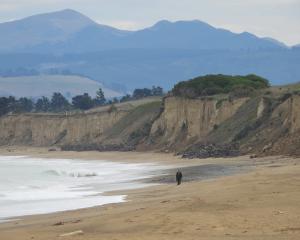The rubbish is being washed out of about a 60m-long face of the old Hampden dump as the sea erodes the former landfill.
It ends up on the coast, then is carried north by the sea and on to Hampden beach, which is a popular picnic and swimming spot.
The Waitaki District Council has been trying to remedy the situation since 2005, but is being held up by a resource consent application to the Otago Regional Council that requires input from the Department of Conservation.
The problem has been dragging on for years, but residents' patience has again been tested by heavy swells during the past week which have eroded more of the dump's face and released more rubbish.
Bent Jansen moved to Hampden about six years ago and, since then, has been trying to get something done.
He walks his dog along the beach and often has to contend with all sorts of rubbish along his path.
That ranges from old car parts through to plastic shopping bags, wire and broken glass, all of which ends up in the sea.
Mr Jansen wonders what the seabed must be like off the old dump site.
The erosion of rubbish was also not a good image for visitors to the Moeraki Boulders, not far south of the dump face, he said.
Visitors regularly made adverse comments about finding rubbish falling out of the dump face and on the beach.
Other residents have also been pushing for a solution.
As well as the district council, the Otago Regional Council has received many complaints.
In October last year, a report to its compliance committee said the site was being monitored and discussions held to resolve the problem.
A walking track, supposedly closed but still popular, leads from the end of Stafford St through the southern edge of the dump site to the beach, even though a "No trespassing" sign has been placed at its entrance.
The sign also warns of the potential hazard of gas leaking from the landfill and possible "dangerous materials".
The edge of the track is slumping as the face of the landfill is eroded.
Located at the end of Stafford St, the old landfill is more than 70 years old.
When it was in use, rubbish was dumped into gullies that led down to the beach.
It was closed about a decade ago and replaced with a transfer station, from which the town's rubbish is taken to the Oamaru landfill.
The Waitaki council has considered several options for resolving the problem, including removing the rubbish to another location.
However, the cost of removal would have been extremely high and Waitaki had no sites available to accept it, the Oamaru and Palmerston landfills being close to capacity.
Any leachate from the dump is not considered to pose a health risk.
Just this week, the council was told an application to the Ministry for the Environment for assistance from the contaminated-sites remediation fund had been turned down.
The Waitaki council applied to the regional council in 2005 for a resource consent for clay protection of the dump face.
However, high seas showed a clay bund was not going to work, so the council applied in August last year for a consent to construct rock bunding, working with the regional council and Doc.
Doc wanted a solution to protect a "cone-in-cone" geological feature in the dump.
The Waitaki council's assets group manager Neil Jorgensen said he hoped an agreement could be reached with Doc at a meeting next Friday.
If it could and a consent was issued, protection work would start as soon as possible.
Mr Jorgensen said Doc's solution - an earth bund - would be more expensive than the council's proposal.
The bund would be eroded by the sea and the council would have the ongoing cost of removing rubbish from the dump face and then reinstating a bund.
The council's solution of a rock bund was long term, but Doc was concerned it could damage the "cone-in-cone" formation.
Doc coastal Otago community relations statutory ranger Charnels Caper said the department was sure issues relating to the landfill could be resolved at the meeting with the district council next week.
He did not want to detail those issues before the meeting.












